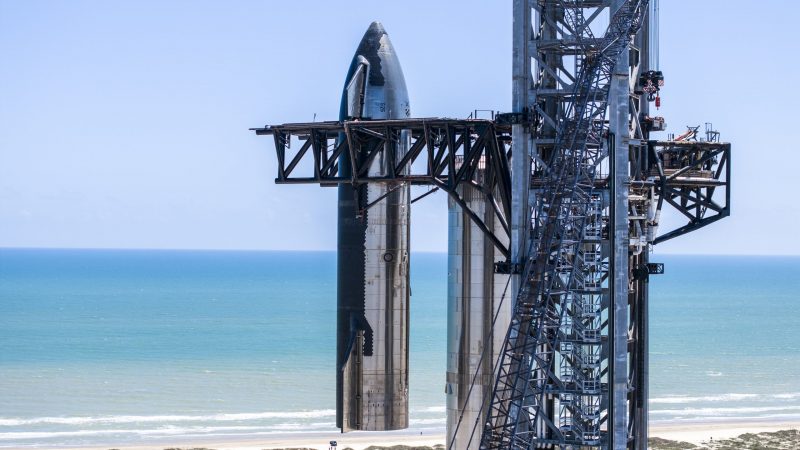Elon elated as Starship makes its test flight goals
SpaceX’s goals for the fourth orbital test flight (OTF) of Starship were gathering mission telemetry and outdoing the performance of OTF 3. The company made both marks during the June 6, 2024 flight.
Starship’s fourth flight test launched with ambitious goals, attempting to go farther than any previous test before and begin demonstrating capabilities central to return and reuse of Starship and Super Heavy.
The payload for this test was the data.
Starship delivered ?… pic.twitter.com/tP0QL3eEOd
— SpaceX (@SpaceX) June 6, 2024
Even founder and CEO Elon Musk was ready to celebrate following the test flight.
Today was a great day for humanity’s future as a spacefaring civilization!
Nothing unites us more than working together towards inspiring objectives.
— Elon Musk (@elonmusk) June 6, 2024
Despite the rousing success, there were challenges, like one of the control paddles melting away during the re-entry. Yet, Starship made it home for the first time.
Starship made a controlled reentry, successfully making it through the phases of peak heating and max aerodynamic pressure and demonstrating the ability to control the vehicle using its flaps while descending through the atmosphere at hypersonic speeds pic.twitter.com/p8bC9UweLx
— SpaceX (@SpaceX) June 6, 2024
#Starship pic.twitter.com/i2e1EAK0rf
— SP?X (@Stonejackit) June 6, 2024
FAA OK’s license for 4th OTF
SpaceX received regulatory permission for the 4th orbital test flight (OTF) of the SpaceX Starship prototype. The Federal Aviation Administration (FAA) issued a revision of the license originally granted in April of 2023. Read it here.
As expected, there is the #SpaceX Starship launch licence by the FAA.https://t.co/Qcu86zLjyA
? Let's go! ? pic.twitter.com/neKHzohK1P
— Marcus House (@MarcusHouse) June 4, 2024
The announcement was made Tuesday (June 4, 2024), a day before SpaceX intended to launch. The company delayed the OTF by one day prior to the FAA’s announcement. This is the third time the FAA revised the Starship license, corresponding to the three prior OTFs.
SpaceX ready to fly Starship again
SpaceX announced flight controllers had the latest version of the Starship Super Heavy lift vehicle ready for another orbital flight test. The 4th attempt was scheduled for no earlier than 7:50 a.m. CDT (12:00 UTC) on June 6, 2024. SpaceX said:
The 4th flight test turns our focus from achieving orbit to demonstrating the ability to return and reuse Starship and Super Heavy. The primary objectives will be executing a landing burn and soft splashdown in the Gulf of Mexico with the Super Heavy booster, and achieving a controlled entry of Starship.
The company made adjustments to the craft, its operating software and launch technique based on the results of the third OFT. SpaceX said:
To accomplish this, several software and hardware upgrades have been made to increase overall reliability and address lessons learned from Flight 3. The SpaceX team will also implement operational changes, including the jettison of the Super Heavy’s hot-stage following boostback to reduce booster mass for the final phase of flight.
Flight 4 followed the same trajectory as the last flight, aiming for a splashdown for the rocket in the Indian Ocean. (The rocket boosters are aiming for the Gulf of Mexico.)
Livestream watch party
EarthSky hosted a watch party for the 4th Starship test flight. You can rewatch the launch in the first viewer, and then landing attempt in the second.
3rd Starship test a success, but no landing
Previously, the third test vehicle rocketed successfully into space at 8:25 a.m. CDT (13:25 UTC) on March 14, 2024.
After liftoff, Starship separated from the rocket booster as planned. Then, the booster used its guidance fins and three of its 33 engines to return for a splashdown in the Gulf of Mexico. Meanwhile, the rocket continued into space, where it successfully opened its payload doors in the vacuum before beginning a controlled reentry. Unfortunately, as SpaceX announced at the end of its live launch coverage on March 14, the upper stage did not survive. You can rewatch the test flight coverage in the SpaceX post below.
Watch Starship’s third flight test ? https://t.co/bJFjLCiTbK https://t.co/1u46r769Vp
— SpaceX (@SpaceX) March 14, 2024
While there was a minor delay for safety, the rocket lifted off exactly as designed once the waters of the Gulf of Mexico were clear of traffic. There were some hitches during the mission, however, as the flight controllers intended to attempt a soft splashdown of the booster. That did not happen, however. SpaceX also intended the upper stage to make a hard splashdown in the Indian Ocean. Instead, it experienced a RUD (Rapid Unplanned Disassembly) in flight.
At the end of the launch coverage, commentators announced the company has four more Starship prototype vehicles ready for testing.
Video from the test flight
Liftoff of Starship! pic.twitter.com/FaNcasuKaq
— SpaceX (@SpaceX) March 14, 2024
Starship’s Raptor engines have ignited during hot-staging separation. Super Heavy is executing the flip maneuver pic.twitter.com/T593ACilyD
— SpaceX (@SpaceX) March 14, 2024
Starship is coasting in space pic.twitter.com/ZFUXMUkufW
— SpaceX (@SpaceX) March 14, 2024
Pez door checkout complete, door closing, and HD views are over @Starlink pic.twitter.com/Kmb2SpMVTu
— SpaceX (@SpaceX) March 14, 2024
Starship re-entering Earth's atmosphere. Views through the plasma pic.twitter.com/HEQX4eEHWH
— SpaceX (@SpaceX) March 14, 2024
SpaceX Starship fans watched 3rd launch prep eagerly
SpaceX had said on March 5, 2024, that it would launch the third test flight of its mighty Starship, pending regulatory approval. The company posted a message on X/Twitter with the new launch date of March 14. Starship launches from SpaceX’s Starbase in Boca Chica, Texas.
In addition, SpaceX said they had made improvements after the first two launches, including flying a new trajectory:
… with Starship targeted to splashdown in the Indian Ocean. This new flight path enables us to attempt new techniques like in-space engine burns while maximizing public safety.
New Starship IFT-3 warning area (shaded in this plot) for Indian Ocean presumably indicates reentry area for a successful Raptor deorbit burn. Consistent with 100 m/s burn over Botswana reducing perigee from 50 km to -250 km. pic.twitter.com/OcFttz9q0V
— Jonathan McDowell (@planet4589) March 11, 2024
SpaceX Starship’s 2nd test flight
On November 18, 2023, Starship made its 2nd test launch a bit after 7 a.m. CT. After a brief delay, the powerful rocketship lifted off slowly and majestically from SpaceX’s Starbase in Boca Chica, Texas.
Liftoff of Starship! pic.twitter.com/qXnGXXZP5k
— SpaceX (@SpaceX) November 18, 2023
Unfortunately, neither stage of the test vehicle survived the flight. Following a successful stage separation about 165 seconds into the mission, the main stage flipped itself around for its planned touchdown in the Gulf of Mexico. Then, it exploded. The RUD – rapid unscheduled disassembly – came about 30 seconds after stage separation.
Stage separation! pic.twitter.com/PipaCW1PDT
— SpaceX (@SpaceX) November 18, 2023
Starship’s 2nd stage continued its journey despite the booster’s explosion. Mission control, however, lost contact with the vehicle soon after. Go here to see Starship’s fiery reentry near Puerto Rico.
A replay of the launch is available on the SpaceX official X/Twitter account.
Watch Starship’s second integrated flight test ? https://t.co/bJFjLCiTbK https://t.co/cahoRQ72lm
— SpaceX (@SpaceX) November 18, 2023
The greatest rocket ever flown
In case you haven’t heard, Starship is the world’s tallest and most powerful rocket. The initial launch came in April 2023 and ended in a dramatic mid-air explosion. Among other problems, the launch also obliterated the concrete launch pad beneath the mighty rocket and blew out some windows.
Afterward, the Federal Aviation Administration (FAA) had questions. And SpaceX could not launch Starship without further FAA approval. The nod from the FAA – which was much awaited by both space fans and SpaceX – arrived just three days before the next hoped-for launch.

What went wrong with SpaceX Starship the 1st time?
SpaceX gave a rundown of how its first attempt to get Starship to orbit went wrong. Indeed, from the moment the engines ignited, there were problems that continued until the vehicle finally exploded about 39 km (24 miles) over the Gulf of Mexico.
With this in mind, the company provided a brief timeline of the flight and how they planned to prevent a repeat of its mishaps:
During ascent, the vehicle sustained fires from leaking propellant in the aft end of the Super Heavy booster, which eventually severed connection with the vehicle’s primary flight computer. This led to a loss of communications to the majority of booster engines and, ultimately, control of the vehicle. SpaceX has since implemented leak mitigations and improved testing on both engine and booster hardware. As an additional corrective action, SpaceX has significantly expanded Super Heavy’s preexisting fire suppression system in order to mitigate against future engine bay fires.
Additionally, it also addressed the disintegration of a massive reinforced concrete slab under the launchpad during liftoff.
SpaceX also made significant upgrades to the orbital launch mount and pad system in order to prevent a recurrence of the pad foundation failure observed during the first flight test. These upgrades include significant reinforcements to the pad foundation and the addition of a flame deflector, which SpaceX has successfully tested multiple times.
Bottom line: The SpaceX Starship – the world’s most powerful rocket – had a successful 4th test flight on Thursday, June 6, 2024. Watch it again here.











